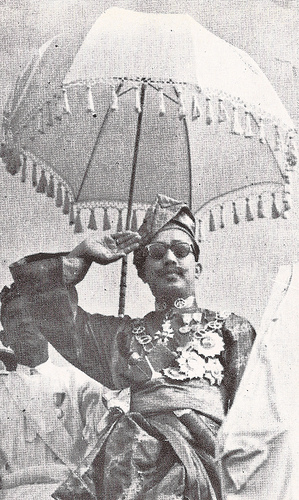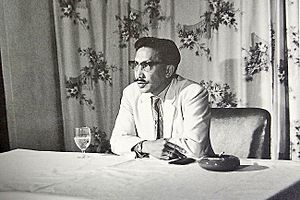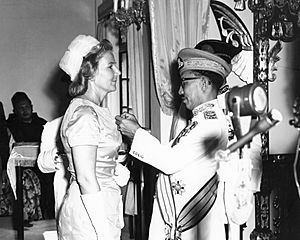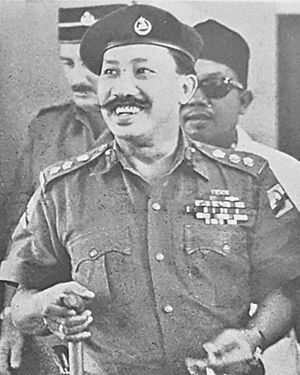Omar Ali Saifuddien III facts for kids
Quick facts for kids Omar Ali Saifuddien III |
|
|---|---|
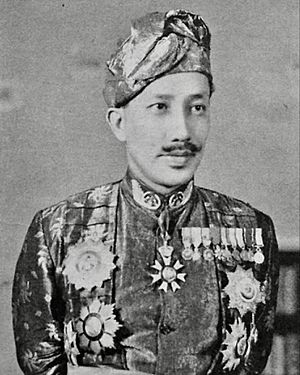
Portrait of Omar 'Ali Saifuddien III in 1960
|
|
| 28th Sultan of Brunei | |
| Reign | 4 June 1950 – 5 October 1967 |
| Coronation | 31 May 1951 |
| Predecessor | Ahmad Tajuddin |
| Successor | Hassanal Bolkiah |
| Minister of Defence Commander-in-Chief of the Royal Brunei Armed Forces |
|
| Tenure | 1 January 1984 – 7 September 1986 |
| Predecessor | Office established |
| Successor | Hassanal Bolkiah |
| Monarch | Hassanal Bolkiah |
| Born | Omar Ali Saifuddien Sa'adul Khairi Waddien 23 September 1914 Brunei Town, Brunei |
| Died | 7 September 1986 (aged 71) Istana Darussalam, Bandar Seri Begawan, Brunei |
| Burial | 8 September 1986 Kubah Makam Di Raja, Brunei Town, Brunei |
| Spouse |
Dayang Siti Amin
(m. 1937; div. 1944)Pengiran Anak Damit
(m. 1941; died 1979)Pengiran Anak Hajah Salhah
(m. 1980) |
| Issue |
|
| Father | Sultan Muhammad Jamalul Alam II |
| Mother | Pengiran Anak Siti Fatimah |
| Religion | Sunni Islam |
Sultan Sir Omar Ali Saifuddien Sa'adul Khairi Waddien (born 23 September 1914 – died 7 September 1986) was the 28th Sultan of Brunei. He ruled from June 4, 1950, until he stepped down on October 5, 1967.
He was also Brunei's first Minister of Defence after the country became independent. People called him "The Architect of Modern Brunei" because he built many important things. He was also known as "The Royal Poet" and "The Father of Independence."
Contents
Early Life and Education
Omar Ali Saifuddien was born in Brunei Town on September 23, 1914. He was the second son of Muhammad Jamalul Alam II and Raja Isteri Fatimah.
He went to Malay College Kuala Kangsar (MCKK) in Malaya from 1932 to 1936. This made him the first Brunei Sultan to get a formal education outside Brunei.
After school, he worked in Brunei's Forestry Department in 1936. Then, he moved to the Judiciary Department in 1937. During the Japanese occupation of Brunei (1941-1945), he worked for the State Secretary. After World War II, he became a member of the Brunei State Council in 1947. He also became the chairman of the Syariah Court.
Sultan of Brunei (1950-1967)
Omar Ali Saifuddien became Sultan on June 6, 1950. This happened after his brother passed away suddenly without any sons. He was crowned Sultan on May 31, 1951.
He visited Mecca in September 1951. He also attended the coronation of Queen Elizabeth II in London in 1953. Queen Elizabeth II gave him special honors.
Brunei's Constitution
Sultan Omar Ali Saifuddien III wanted Brunei to have its own constitution and become independent from the United Kingdom. In July 1953, he created a committee called Tujuh Serangkai. This group gathered ideas from the people for a written constitution.
In March 1959, the Sultan went to London to talk about the new constitution. The British government agreed to the plan. On September 29, 1959, the Constitution Agreement was signed in Brunei Town.
Here are some key points of the new constitution:
- The Sultan became the main leader of Brunei.
- Brunei would manage its own affairs.
- The British government would only handle Brunei's foreign and defense matters.
- The British Resident's job was replaced by a British High Commissioner.
National Development Plans
Sultan Omar Ali Saifuddien III started plans to develop Brunei.
First Development Plan
The First National Development Plan began in 1953. Brunei spent a lot of money to build a Gas Plant. Oil exploration also started, and oil production grew quickly.
Education also improved. In 1952, a written plan for education was made. By 1958, a lot of money was spent on schools. Roads were built, and the Berakas Airport was improved.
Second Development Plan
The Second National Development Plan started in 1962. A large oil and gas field was found in 1963. This made Liquefied Natural Gas (LNG) very important for Brunei. Oil and gas production kept growing.
The plan also helped increase meat and egg production. The fishing industry grew by 25%. A large deepwater port called Muara Port was built. Efforts were made to bring electricity to rural areas. Brunei also worked with the World Health Organization to fight malaria. Malaria cases dropped a lot, and the death rate also went down. This was thanks to better sanitation and clean water.
State Election 1962
Brunei held its first state election on August 30 and 31, 1962. People voted for members to join the Brunei Legislative Council. These members would help discuss government policies. However, the Sultan still had the final say.
The Brunei People's Party (PRB) won the election.
Brunei Revolt
The Prime Minister of Malaya, Tunku Abdul Rahman, suggested that Singapore, North Borneo, Sarawak, and Brunei should merge. Sultan Omar Ali Saifuddien supported this idea. He believed Brunei, as a small country, needed protection from a larger one.
However, the Brunei People's Party (PRB) was against the merger. They felt it would not bring true independence. On December 8, 1962, the PRB started a rebellion against the government. British military help from Singapore quickly stopped the revolt.
After the rebellion, discussions about Brunei joining Malaysia continued. But Brunei and Malaysia could not agree on how to share oil money and taxes. So, Brunei did not join the new federation.
Religious Affairs and Education
As Sultan, Omar Ali Saifuddien also became the head of Islam in Brunei. He helped organize Islamic administration in the country. In 1948, a religious council was formed, and he was its chairman.
He also created the Department of Religious Affairs on July 1, 1954. This department made important decisions about Islam in Brunei. It looked after Islamic activities like community life, laws, education, and social matters.
Important Visitors During His Reign
Many important people visited Brunei while Omar Ali Saifuddien was Sultan:
- On October 21, 1952, Princess Marina, the Duchess of Kent, visited Brunei.
- On July 6, 1959, Abdul Rahman of Negeri Sembilan, the first King of Malaya, visited.
- On March 1, 1965, Prince Philip, the Duke of Edinburgh, visited Brunei.
Abdication
After ruling for 17 years, Sultan Omar Ali Saifuddien decided to step down. On October 4, 1967, he gave the throne to his eldest son, Crown Prince Hassanal Bolkiah. At that time, the Crown Prince was training in England. He returned to Brunei right away.
Coronation of Hassanal Bolkiah
After his father stepped down, Crown Prince Hassanal Bolkiah became the 29th Sultan of Brunei. Omar Ali Saifuddien was then called Seri Begawan Sultan (Retired Sultan).
The coronation ceremony was held on August 1, 1968. The new Sultan rode to the Lapau Building in a royal carriage. Omar Ali Saifuddien placed the crown on his son's head. He also gave him the Keris si-Naga, a symbol of royal power. The new Sultan promised to keep Brunei peaceful and improve life for its people. He also promised to protect Islam and Brunei's traditions.
Many important guests attended, including the prime ministers of Singapore and Malaysia.
Later Life
After stepping down at age 53, he was called Paduka Seri Begawan Sultan. He held this title until he passed away in 1986. He received another special honor from Queen Elizabeth II in 1972.
He continued to be involved in important events. He signed agreements about Brunei's future. He also attended the opening of Brunei's national stadium, the Hassanal Bolkiah National Stadium, in 1983. It was one of the most modern stadiums in Southeast Asia.
Brunei's Independence
On December 31, 1983, at midnight, Sultan Hassanal Bolkiah officially announced that Brunei Darussalam was fully independent. This happened after 97 years of British protection.
After the announcement, Omar Ali Saifuddien led the people in chanting Allahu Akbar (God is Great). This was followed by the national anthem and a prayer.
After Independence
Even though he had stepped down, he still played an important role. His son, Sultan Hassanal Bolkiah, appointed him as the Minister of Defence in Brunei's first group of cabinet ministers. He also welcomed Yasser Arafat, the leader of the Palestine Liberation Organization, to Brunei in 1984.
Death
Omar Ali Saifuddien passed away on September 7, 1986, at the age of 71. He had been sick for several weeks. He was given a state funeral the next day.
Churchill Memorial Building
Omar Ali Saifuddien greatly admired Winston Churchill, the British Prime Minister during World War II. In 1971, he opened the Churchill Memorial Building in Brunei Town. This building was the only museum in the world dedicated only to Winston Churchill. It cost about $5 million.
Later, in 1992, this building became the Royal Brunei Regalia Building. In 2017, it was renamed the Royal Regalia Museum.
Personal Life
Family
His first wife was Dayang Siti Amin. They had no children and divorced in 1944. On September 6, 1941, he married his cousin, Pengiran Anak Damit. She gave birth to 10 children:
- Sultan Hassanal Bolkiah (born 1946)
- Prince Mohamed Bolkiah (born 1947)
- Prince Sufri Bolkiah (born 1951)
- Prince Jefri Bolkiah (born 1954)
- Princess Masna Bolkiah (born 1948)
- Princess Nor'ain Bolkiah (born 1950)
- Princess Amal Umi Kalthum Al-Islam Bolkiah (born 1956)
- Princess Amal Rakiah Bolkiah (born 1957)
- Princess Amal Nasibah Bolkiah (born 1960)
- Princess Amal Jefriah Bolkiah (born 1963)
His wife, Pengiran Anak Damit, passed away on September 13, 1979. Later, he married Pengiran Anak Hajah Salhah, who was his sister-in-law.
Personal Interests
He enjoyed writing poems. He also designed national medals for Brunei. He even created a special flower design for his clothes, called "Tenunan Brunei." He was also interested in self-defense martial arts like silat and kuntau.
Legacy
Namesakes
Many places and buildings are named after him:
- The capital city, Brunei Town, was renamed Bandar Seri Begawan in his honor in 1970. "Begawan" was his title after he stepped down.
- The beautiful Sultan Omar Ali Saifuddin Mosque was completed in 1958 and named after him.
- Taman Haji Sir Muda Omar Ali Saifuddien, a park in the capital.
- Sultan Omar Ali Saifuddien College, a school.
- The Seri Begawan Religious Teaching University.
- The Sultan Omar Ali Saifuddien Institute of Islamic Studies at Universiti Brunei Darussalam.
- The Paduka Seri Begawan Sultan Science College.
- The Paduka Seri Begawan Sultan Omar Ali Saifuddien Mosque in Kampong Katimahar.
- The Temburong Bridge, the longest bridge in Southeast Asia, was named after him in 2020. This was to recognize his role as "The Architect of Modern Brunei."
Appearance in Currency
- His picture is on Brunei's coins from 1967 (1, 5, 10, 20, and 50 cent).
- His portrait is also on all the first banknotes issued in 1967 (1, 5, 10, 50, and 100 ringgit/dollar).
- You can also see his portrait on Brunei's current 500 ringgit/dollar notes from 2006 and 2013.
- A picture of him crowning his son is on the back of a special 25 ringgit/dollar note from 1992.
Honours
He received many special honors from different countries:
- From the United Kingdom:
- Honorary Companion of the Order of St Michael and St George (1951)
- Honorary Knight Commander of the Order of St Michael and St George (1953)
- Honorary Knight Grand Cross of the Royal Victorian Order
- From Malaya:
- Honorary Recipient of the Order of the Crown of the Realm (1958)
- From Johor:
- First Class of the Royal Family Order of Johor (1960)
- From Selangor:
- First Class of the Royal Family Order of Selangor (1961)
See also
 In Spanish: Omar Ali Saifuddien III para niños
In Spanish: Omar Ali Saifuddien III para niños


